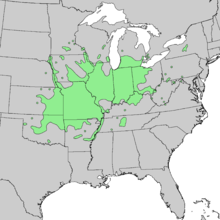Kentucky coffeetree
| Kentucky coffeetree | |
|---|---|
 |
|
| Gymnocladus dioicus | |
| Scientific classification | |
| Kingdom: | Plantae |
| (unranked): | Angiosperms |
| (unranked): | Eudicots |
| (unranked): | Rosids |
| Order: | Fabales |
| Family: | Fabaceae |
| Subfamily: | Caesalpinioideae |
| Genus: | Gymnocladus |
| Species: | G. dioicus |
| Binomial name | |
|
Gymnocladus dioicus (L.) K. Koch |
|
 |
|
| Natural range | |
| Synonyms | |
|
Gymnocladus canadensis Lam. |
|
Gymnocladus canadensis Lam.
The Kentucky coffeetree, Gymnocladus dioicus, is a tree in the subfamily Caesalpinioideae of the pea family Fabaceae, native to the Midwest and Upper South of North America. The seed may be roasted and used as a substitute for coffee beans; however, unroasted pods and seeds are toxic. The wood from the tree is used by cabinetmakers and carpenters.
From 1976 to 1994 the Kentucky coffeetree was the state tree of Kentucky, after which the tulip poplar was returned to that designation.
Varies from 18 to 21 meters (60–70 feet) high with a spread of 12–15 meters (40–50 feet) and a trunk up to one meter (3 feet) in diameter. A 10-year-old sapling will stand about 4 meters (13 feet) tall. It usually separates 3 to 4½ meters (10–15 feet) from the ground into three or four divisions which spread slightly and form a narrow pyramidal head; or when crowded by other trees, sending up one tall central branchless shaft to the height of 15–21 m (50–70 ft). Branches are stout, pithy, and blunt; roots are fibrous.
The Kentucky coffeetree is a moderately fast-growing tree, and male trees are often grown in parks and along city streets for ornamental purposes. The tree is typically long-lived, healthy trees living from 100 to 150 years. The Kentucky coffeetree sheds its leaves early during the fall and appears bare for up to 6 months. The naked appearance of the tree is reflected through the Kentucky coffeetree's Greek genus name, which means "naked branch". Like the Sumac, branches are absent of fine spray; smaller branches are thick and lumpish. Because of the absence of smaller branches and its later leafing, the French in Canada named it Chicot, the dead tree. . The expanding leaves are conspicuous because of the varied colors of the leaflets; the youngest are bright pink, while those which are older vary from green to bronze.
The bark is ash-gray and scaly, flaking similarly to black cherry, but more so. The flowers are dioecious, and the fruit is a hard-shelled bean in heavy, woody, thick-walled pods filled with sweet, thick, gooey pulp. Pod length ranges from 5 to 10 inches (130 to 250 mm); unfertilized female trees may bear miniature seedless pods. The beans contain the toxin cytisine.
...
Wikipedia

